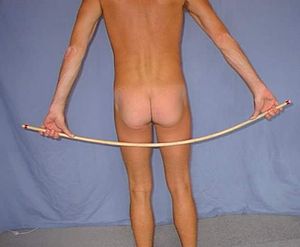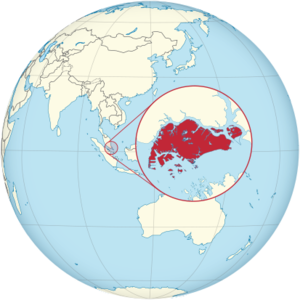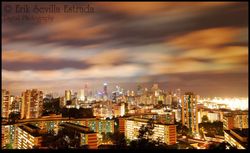Singapore
| Singapore |
|
|
Singapore (Singapura, officially the Republic of Singapore), is an island city-state in Southeast Asia, located at the southern tip of the Malay Peninsula. Its population is about 4.6 million, most of which live in Singapore City.
The majority of the population is ethnic Chinese. Minorities include Malays, Indians, Indonesians, and non-Asians. The nation's official languages are English, Mandarin, Malay, and Tamil.
Modern Singapore was founded in 1819 by Sir Stamford Raffles as a trading post of the British Empire. In 1867, the colonies in Southeast Asia were reorganized and Singapore came under the direct control of Britain as part of the Straits Settlements. During the Second World War, Singapore was occupied by Japan in 1942 and returned to British control as a separate crown colony following Japan's surrender in 1945. Singapore gained self-governance in 1959 and in 1963 became part of the new federation of Malaysia, alongside Malaya, North Borneo, and Sarawak. Ideological differences led to Singapore being expelled from the federation two years later and it became an independent country.
After early years of turbulence and despite lacking natural resources and a hinterland, the nation rapidly developed to become one of the Four Asian Tigers based on external trade, becoming a highly developed country; it is ranked ninth on the UN Human Development Index and has the second-highest GDP per capita (PPP) in the world. Singapore is the only country in Asia with a AAA sovereign rating from all major rating agencies. It is a major financial and shipping hub, consistently ranked the most expensive city to live in since 2013, and has been identified as a tax haven. Singapore is placed highly in key social indicators: education, healthcare, quality of life, personal safety, and housing, with a home-ownership rate of 91%. Singaporeans enjoy one of the world's longest life expectancies, the fastest Internet connection speeds, and one of the lowest infant mortality rates in the world.
Singapore is a unitary parliamentary republic with a Westminster system of unicameral parliamentary government. While elections are considered generally free, the government exercises significant control over politics and society, and the People's Action Party has ruled continuously since independence.
Spanking in Singapore
Spanking of children for discipline is common in Singapore. The traditional and most common spanking implement for children is the thin and whippy rattan cane. It is sold for this purpose in grocery stores. Today, about 20% of parents were found to use this form of discipline in a survey (source: Straits Times, 17 September 2004).
Singaporean schools are known for their strict, almost military, military drills and high standards of discipline. School uniforms are mandatory. School corporal punishment exists (in the form of caning), but only for male students, applied to the boy's clothed buttocks.
Judicial caning in Singapore

Like its neighbour country Malaysia, Singapore law includes judicial corporal punishment for various crimes. It is given as a number of full-force strokes with a long rattan cane to the bared buttocks of the delinquent, who is restrained in a caning trestle in a bending-over position. The rattan cane is 1.2 meters long and up to 1.27 cm thick (Prison Regulations 132(2)), i.e. considerably thicker and heavier than a school cane. Parts of the prisoner's body are padded to prevent accidental damaging of the kidneys and the genitals. Such a judicial caning usually draws blood and can, in the case of a large number of strokes, leave permanent scars. Only male criminals under 50 are subject to judicial caning; female criminals are not caned.
Thousands of male criminals are caned in Singapore each year for both violent and non-violent offenses such as vandalism, overstaying one's visa or illegal immigration. Caning is never ordered on its own, but always as an addition to a prison sentence.
The punishment is carried out privately in a prison, in the presence of a prison officer and a medical officer. Contrary to widespread belief, it is never administered in public, and never has been. The caning is carried out in a single session, and not by 'installments'. Thus, a person sentenced to 24 strokes of the cane (the maximum possible sentence) will have the entire sentence carried out at once. The persons carrying out the caning are specially trained prison officers.
A smaller cane is used for juvenile offenders (boys under 16), who may be sentenced to caning only by the High Court and not by the local courts. There are a few dozen of these canings of boys per year.
The Michael Fay caning incident
Michael Fay (b. 1975) is an American who briefly shot to worldwide fame when he was sentenced to caning in Singapore as an 18-year-old in 1994 for theft and vandalism. Caning is a routine court sentence in Singapore but most Americans were unfamiliar with it, and Fay's case was the first caning involving an American citizen.
The sentence created an international incident that stirred up a great deal of public outrage and ignited a fierce debate in the media over the issue of judicial caning as well as the controversy surrounding the use of corporal punishment in general. U.S. President Bill Clinton asked the Singapore government to waive the caning, which he called "excessive." After losing an appeal against his sentence, Fay asked Singapore's President Ong Teng Cheong for clemency.
On May 4, 1994 the government announced that Fay's caning had been reduced from six to four strokes as a gesture of respect for the American president.
Shades of Singapore book
Within months of the Michael Fay affair, a paperback book was published entitled Shades of Singapore: Sister Sarah Balfour's Memoirs of Judicial Caning in South Africa, Vol. I, by Angus Balfour (New York: Blue Moon Books, 1994). This 294-page novel of punishment erotica purports to be the memoirs of a retired Nursing Sister who took part in dozens of court-appointed canings of women in pre-war South Africa.
The original title, Judicial Female Corporal Punishment Memoirs, appears on the contents page. It is indicative of the widespread notoriety of the Fay controversy that a book set in South Africa in the 1930s would have its title hastily altered to capitalize on a contemporary incident in Singapore.
Singaporean spanking artists
None known so far.
See also
External links
- Criminal Procedure Code
- Corpun: Judicial Caning in Singapore, Malaysia and Brunei on World Corporal Punishment Research
- More information is available at [ Wikipedia:Singapore ]
- More information is available at [ Wikipedia:Caning_in_Singapore ]

- More information is available at [ Wikipedia:Caning_in_Singapore ]
Chat rooms • What links here • Copyright info • Contact information • Category:Root


